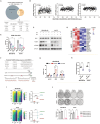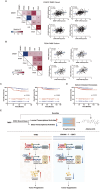Dual Inhibition of CDK4/6 and CDK7 Suppresses Triple-Negative Breast Cancer Progression via Epigenetic Modulation of SREBP1-Regulated Cholesterol Metabolism
- PMID: 39656925
- PMCID: PMC11791979
- DOI: 10.1002/advs.202413103
Dual Inhibition of CDK4/6 and CDK7 Suppresses Triple-Negative Breast Cancer Progression via Epigenetic Modulation of SREBP1-Regulated Cholesterol Metabolism
Abstract
Inhibitors targeting cyclin-dependent kinases 4 and 6 (CDK4/6) to block cell cycle progression have been effective in treating hormone receptor-positive breast cancer, but triple-negative breast cancer (TNBC) remains largely resistant, limiting their clinical applicability. The study reveals that transcription regulator cyclin-dependent kinase7 (CDK7) is a promising target to circumvent TNBC's inherent resistance to CDK4/6 inhibitors. Combining CDK4/6 and CDK7 inhibitors significantly enhances therapeutic effectiveness, leading to a marked decrease in cholesterol biosynthesis within cells. This effect is achieved through reduced activity of the transcription factor forkhead box M1 (FOXM1), which normally increases cholesterol production by inducing SREBF1 expression. Furthermore, this dual inhibition strategy attenuates the recruitment of sterol regulatory element binding transcription factor 1 (SREBP1) and p300 to genes essential for cholesterol synthesis, thus hindering tumor growth. This research is corroborated by an in-house cohort showing lower survival rates in TNBC patients with higher cholesterol production gene activity. This suggests a new treatment approach for TNBC by simultaneously targeting CDK4/6 and CDK7, warranting additional clinical trials.
Keywords: CDK4/6; CDK7; breast cancer; cholesterol metabolism.
© 2024 The Author(s). Advanced Science published by Wiley‐VCH GmbH.
Conflict of interest statement
The authors declare no conflict of interest.
Figures






References
MeSH terms
Substances
Grants and funding
LinkOut - more resources
Full Text Sources
Medical
Miscellaneous
